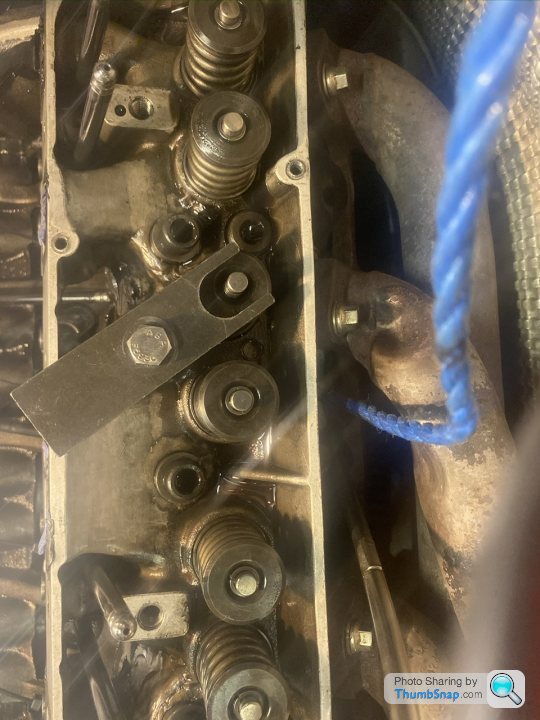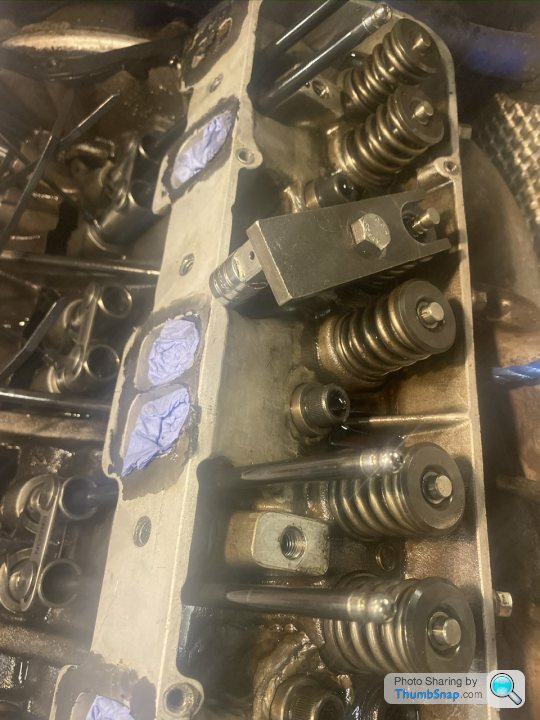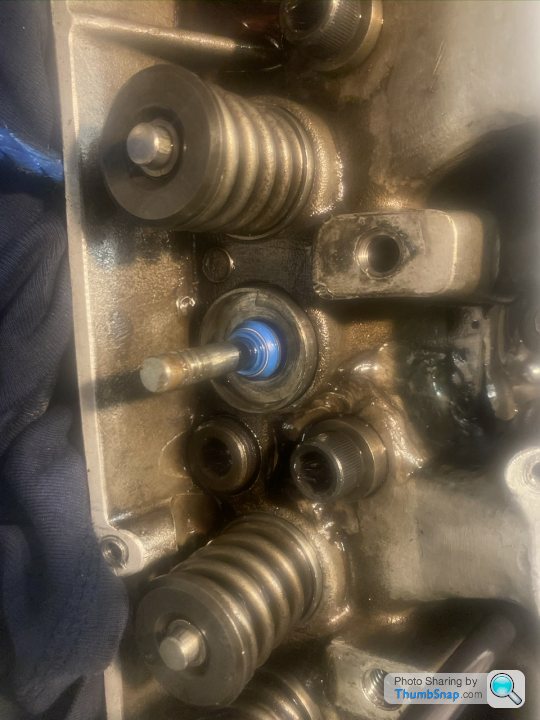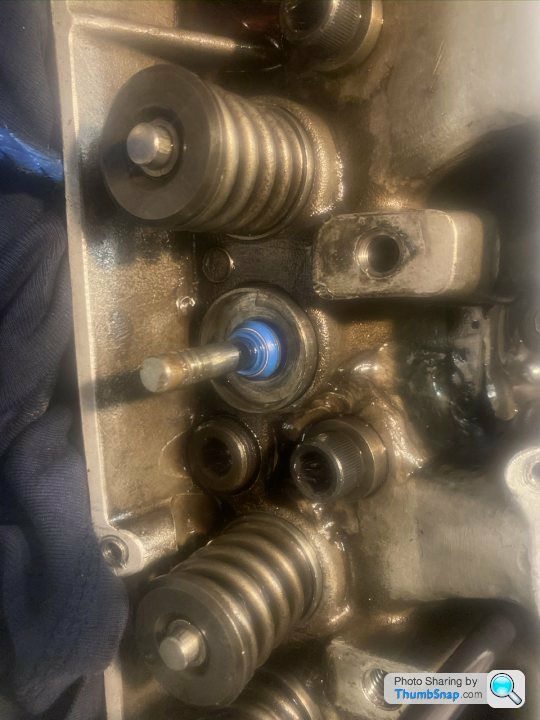talk to me about valve stem oil seals - SIMON?????? :)
Discussion
Posting this here rather than in the engines section as I know many of you clever people have rebuilt your rover v8s and will have investigated this already .. there's probably more relevant info to be had in here than the general engine section.
What's flavour of the month on valve stem oil seals ? Any to avoid ? Are neoprene still the ones to go for .. or nitrile .. or anything else?
Hoping to change seals with the heads still on the engine .. not too keen on stripping it all unless I absolutely have to. Anybody done this and got a pic of a suitable tool to make up before I start ..
cheers
What's flavour of the month on valve stem oil seals ? Any to avoid ? Are neoprene still the ones to go for .. or nitrile .. or anything else?
Hoping to change seals with the heads still on the engine .. not too keen on stripping it all unless I absolutely have to. Anybody done this and got a pic of a suitable tool to make up before I start ..
cheers
Hi Jools sorry missed this however if your referring to this Simon  I have never tried changing them in situ on the RV8
I have never tried changing them in situ on the RV8  if we are EFI style stem seals (not early guide washer style) then I favour Elring/Victor Reinz/Payen etc etc Paul@V8 Tuner does Victor Reinz IIRC for a stock repair, I used states Comp Cams Viton seals for the .494 guide for using triple springs on Chevy/Ford V8's etc they are slim small bodied as I recall and not necessary for your repair bust just for info really
if we are EFI style stem seals (not early guide washer style) then I favour Elring/Victor Reinz/Payen etc etc Paul@V8 Tuner does Victor Reinz IIRC for a stock repair, I used states Comp Cams Viton seals for the .494 guide for using triple springs on Chevy/Ford V8's etc they are slim small bodied as I recall and not necessary for your repair bust just for info really 
 I have never tried changing them in situ on the RV8
I have never tried changing them in situ on the RV8  if we are EFI style stem seals (not early guide washer style) then I favour Elring/Victor Reinz/Payen etc etc Paul@V8 Tuner does Victor Reinz IIRC for a stock repair, I used states Comp Cams Viton seals for the .494 guide for using triple springs on Chevy/Ford V8's etc they are slim small bodied as I recall and not necessary for your repair bust just for info really
if we are EFI style stem seals (not early guide washer style) then I favour Elring/Victor Reinz/Payen etc etc Paul@V8 Tuner does Victor Reinz IIRC for a stock repair, I used states Comp Cams Viton seals for the .494 guide for using triple springs on Chevy/Ford V8's etc they are slim small bodied as I recall and not necessary for your repair bust just for info really 
Edited by Zener on Saturday 9th May 12:19
Can someone give me an over view of this please? My 3.9 pre serp never had any valve seals of any sorts from new. I bought some oil seals for that engine that where simply very small O rings that fitted over the valve stem, but obviously would not do anything unless the valve was fully open, so a complete waste of time. Are the units you are talking about a press fit over the valve guide? My oil consumption has been terrible since the engine was brand new, but I have problems believing this would not have been a problem on all the pre serp engines if no seals where fitted by the factory?
Early heads didnt have the step to accommodate the later stem seals Mark  possibly around 92 did the later step guides become fitted not surprising as CAT/emission regs were imminent IIRC
possibly around 92 did the later step guides become fitted not surprising as CAT/emission regs were imminent IIRC  you can get your tops machined or there is a 80's Vauxhall stem seal that can be fitted I think this was from the CIH engine 2.0/2.2 Cavalier/Manta/Carlton engine possibly , dont know how successful this is I have never tried , my solution would be to get your tops machined (not expensive) rather than change guides
you can get your tops machined or there is a 80's Vauxhall stem seal that can be fitted I think this was from the CIH engine 2.0/2.2 Cavalier/Manta/Carlton engine possibly , dont know how successful this is I have never tried , my solution would be to get your tops machined (not expensive) rather than change guides  whilst changing guides is no hard ship and bulleted ones are cheap from the like of Real-Steel etc post machining i.e reaming guides, valves & seats re-cutting to keep valve and seat concentric wont be so cheap
whilst changing guides is no hard ship and bulleted ones are cheap from the like of Real-Steel etc post machining i.e reaming guides, valves & seats re-cutting to keep valve and seat concentric wont be so cheap  the RV8 is not hard on valve guide life IMO so I would go with the machine tops of your guides or the early Vauxhall/GM route possibly , unlike some OHV rocker mounted engine these do have a lot of oil flow around the rocker gear possibly contributing to oil consumption
the RV8 is not hard on valve guide life IMO so I would go with the machine tops of your guides or the early Vauxhall/GM route possibly , unlike some OHV rocker mounted engine these do have a lot of oil flow around the rocker gear possibly contributing to oil consumption
 possibly around 92 did the later step guides become fitted not surprising as CAT/emission regs were imminent IIRC
possibly around 92 did the later step guides become fitted not surprising as CAT/emission regs were imminent IIRC  you can get your tops machined or there is a 80's Vauxhall stem seal that can be fitted I think this was from the CIH engine 2.0/2.2 Cavalier/Manta/Carlton engine possibly , dont know how successful this is I have never tried , my solution would be to get your tops machined (not expensive) rather than change guides
you can get your tops machined or there is a 80's Vauxhall stem seal that can be fitted I think this was from the CIH engine 2.0/2.2 Cavalier/Manta/Carlton engine possibly , dont know how successful this is I have never tried , my solution would be to get your tops machined (not expensive) rather than change guides  whilst changing guides is no hard ship and bulleted ones are cheap from the like of Real-Steel etc post machining i.e reaming guides, valves & seats re-cutting to keep valve and seat concentric wont be so cheap
whilst changing guides is no hard ship and bulleted ones are cheap from the like of Real-Steel etc post machining i.e reaming guides, valves & seats re-cutting to keep valve and seat concentric wont be so cheap  the RV8 is not hard on valve guide life IMO so I would go with the machine tops of your guides or the early Vauxhall/GM route possibly , unlike some OHV rocker mounted engine these do have a lot of oil flow around the rocker gear possibly contributing to oil consumption
the RV8 is not hard on valve guide life IMO so I would go with the machine tops of your guides or the early Vauxhall/GM route possibly , unlike some OHV rocker mounted engine these do have a lot of oil flow around the rocker gear possibly contributing to oil consumption Hello Jools.
Hope you are keeping well.
By coincidence I have just changed all my valve stem oil seals to cure an occasional cloud of smoke after a cold start using blue rope fed into each cylinder. You can see the simple bracket used to compress the valve spring. Works a treat if a bit slow and tedious.
Take care mate.
Andy



Hope you are keeping well.
By coincidence I have just changed all my valve stem oil seals to cure an occasional cloud of smoke after a cold start using blue rope fed into each cylinder. You can see the simple bracket used to compress the valve spring. Works a treat if a bit slow and tedious.
Take care mate.
Andy



Else just a heads up  but this pedestal pad/base looks like it has a raised burr/knick
but this pedestal pad/base looks like it has a raised burr/knick  just run your nail across it to check you dont want any cocking over of the pedestal/support when its concerning your rocker gear
just run your nail across it to check you dont want any cocking over of the pedestal/support when its concerning your rocker gear  if so its just ally and easy dressed off with a file whilst collecting the debri
if so its just ally and easy dressed off with a file whilst collecting the debri  like I say may be just the pic angle , and that protruding threaded insert beside it should of be set flat or at least ground level with the head face because if your using rubber gaskets with the distance spacers its going to have an effect on gasket pre-load and thus sealing ................... ..................
like I say may be just the pic angle , and that protruding threaded insert beside it should of be set flat or at least ground level with the head face because if your using rubber gaskets with the distance spacers its going to have an effect on gasket pre-load and thus sealing ................... .................. 
 but this pedestal pad/base looks like it has a raised burr/knick
but this pedestal pad/base looks like it has a raised burr/knick  just run your nail across it to check you dont want any cocking over of the pedestal/support when its concerning your rocker gear
just run your nail across it to check you dont want any cocking over of the pedestal/support when its concerning your rocker gear  if so its just ally and easy dressed off with a file whilst collecting the debri
if so its just ally and easy dressed off with a file whilst collecting the debri  like I say may be just the pic angle , and that protruding threaded insert beside it should of be set flat or at least ground level with the head face because if your using rubber gaskets with the distance spacers its going to have an effect on gasket pre-load and thus sealing ................... ..................
like I say may be just the pic angle , and that protruding threaded insert beside it should of be set flat or at least ground level with the head face because if your using rubber gaskets with the distance spacers its going to have an effect on gasket pre-load and thus sealing ................... .................. 
Zener said:
Early heads didnt have the step to accommodate the later stem seals Mark  possibly around 92 did the later step guides become fitted not surprising as CAT/emission regs were imminent IIRC
possibly around 92 did the later step guides become fitted not surprising as CAT/emission regs were imminent IIRC  you can get your tops machined or there is a 80's Vauxhall stem seal that can be fitted I think this was from the CIH engine 2.0/2.2 Cavalier/Manta/Carlton engine possibly , dont know how successful this is I have never tried , my solution would be to get your tops machined (not expensive) rather than change guides
you can get your tops machined or there is a 80's Vauxhall stem seal that can be fitted I think this was from the CIH engine 2.0/2.2 Cavalier/Manta/Carlton engine possibly , dont know how successful this is I have never tried , my solution would be to get your tops machined (not expensive) rather than change guides  whilst changing guides is no hard ship and bulleted ones are cheap from the like of Real-Steel etc post machining i.e reaming guides, valves & seats re-cutting to keep valve and seat concentric wont be so cheap
whilst changing guides is no hard ship and bulleted ones are cheap from the like of Real-Steel etc post machining i.e reaming guides, valves & seats re-cutting to keep valve and seat concentric wont be so cheap  the RV8 is not hard on valve guide life IMO so I would go with the machine tops of your guides or the early Vauxhall/GM route possibly , unlike some OHV rocker mounted engine these do have a lot of oil flow around the rocker gear possibly contributing to oil consumption
the RV8 is not hard on valve guide life IMO so I would go with the machine tops of your guides or the early Vauxhall/GM route possibly , unlike some OHV rocker mounted engine these do have a lot of oil flow around the rocker gear possibly contributing to oil consumption
Thanks for the oveview. I wont worry about it for now, just chuck the odd pint of oil in. If my piggy bank gets full enough Ill just get the heads swapped out for later ones stage 1 or 2. possibly around 92 did the later step guides become fitted not surprising as CAT/emission regs were imminent IIRC
possibly around 92 did the later step guides become fitted not surprising as CAT/emission regs were imminent IIRC  you can get your tops machined or there is a 80's Vauxhall stem seal that can be fitted I think this was from the CIH engine 2.0/2.2 Cavalier/Manta/Carlton engine possibly , dont know how successful this is I have never tried , my solution would be to get your tops machined (not expensive) rather than change guides
you can get your tops machined or there is a 80's Vauxhall stem seal that can be fitted I think this was from the CIH engine 2.0/2.2 Cavalier/Manta/Carlton engine possibly , dont know how successful this is I have never tried , my solution would be to get your tops machined (not expensive) rather than change guides  whilst changing guides is no hard ship and bulleted ones are cheap from the like of Real-Steel etc post machining i.e reaming guides, valves & seats re-cutting to keep valve and seat concentric wont be so cheap
whilst changing guides is no hard ship and bulleted ones are cheap from the like of Real-Steel etc post machining i.e reaming guides, valves & seats re-cutting to keep valve and seat concentric wont be so cheap  the RV8 is not hard on valve guide life IMO so I would go with the machine tops of your guides or the early Vauxhall/GM route possibly , unlike some OHV rocker mounted engine these do have a lot of oil flow around the rocker gear possibly contributing to oil consumption
the RV8 is not hard on valve guide life IMO so I would go with the machine tops of your guides or the early Vauxhall/GM route possibly , unlike some OHV rocker mounted engine these do have a lot of oil flow around the rocker gear possibly contributing to oil consumption blitzracing said:
Thanks for the oveview. I wont worry about it for now, just chuck the odd pint of oil in. If my piggy bank gets full enough Ill just get the heads swapped out for later ones stage 1 or 2.
Actually presumed you were running modded heads on that little gem Mark  so yes good call
so yes good call Zener said:
Actually presumed you were running modded heads on that little gem Mark  so yes good call
so yes good call
I did a home port job on that, took me days and matched all the ports to the gaskets, and tried to taper off the valve guides, but I was working on the basis big ports are good ports. I had no idea about valve seat angles or the ideal port shape to prevent swirl or maximise airflow. Mind you even a few hundred horsepower in 870 kg and very basic chassis that was designed originally on the pinto powered G27 is hairy to say the least, so I've not been on a horse power quest. so yes good call
so yes good call I replaced the valve stem seals on my old W124 Mercedes 3 litre, twice - about 100,000 miles apart, though. The first time, I borrowed a professional tool that operated similar to this one:
https://www.eurocarparts.com/p/sealey-vs160-valve-...
and I used the 'blue rope fed into the cylinder' method to keep the valves from dropping in. This worked a treat, but you need to be sure you've fed in enough rope to fill the chamber sufficiently.
The second time, I bought a cheap collet release tool which was a bit like a pair of pliers with cam action - this worked, but it was fiddly and seemed barely man enough for the job, but it did manage all 12 valves. To keep the valves from dropping in, I made an airline adapter from an old compression tester hose, and screwed this in place of the spark plug, then let fly with the compressor to pressurise the combustion chamber. This was much quicker than feeding in the blue rope, and it worked very well. There was a lot of crossing of fingers when I popped the collets of the first valve though; visions of the valve disappearing from view were uppermost in mind, but thankfully were quite unfounded. By the time I'd done a few valves, I was very confident of the method.
I did keep a torch handy in case of a power cut mid job - reckon I could have secured the valve in time if the compressor stopped working unexpectedly, before pressure was lost.
If doing the job again, I'd use a tool like the one I linked above, and probably the air pressure method. The RV8 engine is rather less accessible than my Mercedes inline six though, so you'd need to check if you have adequate access room to use the tool.
Good luck.
https://www.eurocarparts.com/p/sealey-vs160-valve-...
and I used the 'blue rope fed into the cylinder' method to keep the valves from dropping in. This worked a treat, but you need to be sure you've fed in enough rope to fill the chamber sufficiently.
The second time, I bought a cheap collet release tool which was a bit like a pair of pliers with cam action - this worked, but it was fiddly and seemed barely man enough for the job, but it did manage all 12 valves. To keep the valves from dropping in, I made an airline adapter from an old compression tester hose, and screwed this in place of the spark plug, then let fly with the compressor to pressurise the combustion chamber. This was much quicker than feeding in the blue rope, and it worked very well. There was a lot of crossing of fingers when I popped the collets of the first valve though; visions of the valve disappearing from view were uppermost in mind, but thankfully were quite unfounded. By the time I'd done a few valves, I was very confident of the method.
I did keep a torch handy in case of a power cut mid job - reckon I could have secured the valve in time if the compressor stopped working unexpectedly, before pressure was lost.
If doing the job again, I'd use a tool like the one I linked above, and probably the air pressure method. The RV8 engine is rather less accessible than my Mercedes inline six though, so you'd need to check if you have adequate access room to use the tool.
Good luck.
I've changed them in situ, using an air compressor linked to a plug hole adaptor to keep the valves seated. Do-able but tedious, and a tad fiddly on a Chimaera for the ones immediately under the scuttle.
Used modern style seals with the springs in the top (not sure of make or material but they were blue I can recall), as my guides were machined to take them on my V8D heads. As to whether oil consumption improved as a result, who knows; I was very friendly with the local Valvoline supplier!
Used modern style seals with the springs in the top (not sure of make or material but they were blue I can recall), as my guides were machined to take them on my V8D heads. As to whether oil consumption improved as a result, who knows; I was very friendly with the local Valvoline supplier!
Just thought I would update this
.. half way through this job right now using the thin rope in spark plug hole method which is working just fine.
Hardest part by far is breaking the stiction on the original seals to get them out, everything else is relatively straightforward.
cheers all
.. half way through this job right now using the thin rope in spark plug hole method which is working just fine.
Hardest part by far is breaking the stiction on the original seals to get them out, everything else is relatively straightforward.
cheers all
Gassing Station | General TVR Stuff & Gossip | Top of Page | What's New | My Stuff







 ) so just said what I see hope its helpful, the burr raising (if it is) would concern me more however
) so just said what I see hope its helpful, the burr raising (if it is) would concern me more however